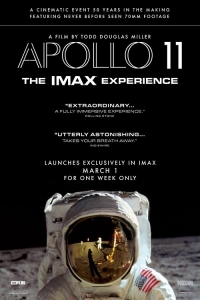The film is constructed from 100% archival footage, shot by or with the permission of NASA, during the Apollo 11 mission. But the wonder of it stems from the fact that the filmmakers “discovered” (with the help of the National Archives and Records Administration) some 165 reels of large format 70mm film shot in 1969 by Theo Kamecke (in 65mm Todd-AO format) for an MGM film called Moonwalk One. Fully 61 of those reels were directly related to the Apollo 11 mission. And most of the footage hadn’t been seen in decades, as it represented unused leftovers from that project. (You can read more about this discovery here at Vanity Fair and here at my friend Robert Perlman’s CollectSpace website.)
I’m trying to think of another documentary discovery that would be equivalent, and all I can come up with is this: It’s as if the lost combat camera film footage from the Allied invasion of Normandy in 1944 – notoriously lost when a soldier carrying it back to ships offshore on D-Day accidentally dropped the bag containing it into the English Channel – hadn’t actually been lost but just misplaced in a government archive somewhere.
What the discovery of this mislaid Apollo 11 footage means is that there’s a whole new perspective on aspects of this mission that none of us have ever seen before. And the clarity and quality of this footage is remarkable. Among the cache of footage are views of the crawler transporter carrying the Saturn V rocket to the launch pad, thousands of Americans gathering around the space center to view the launch, notables like Johnny Carson, Isaac Asimov, Jack Benny, and President Lyndon Johnson in the VIP stands, new views of the rocket on the pad, footage of the hundreds of engineers and controllers in the Launch Control Center, and views of the recovery operations at sea on the USS Hornet. It’s a treasure trove.
What Miller and his team have done is to marry that footage with the best of the previous documentary film to tell the story of the mission, from the arrival of the rocket on the pad and the astronauts suiting up for launch until the moment they emerge from their period of bio-isolation after the mission. But there’s no narrator – through the entire film, you’re hearing the voices of the actual astronauts, mission controllers, and members of the press (Walter Cronkite, in particular) who participated in the mission.
This is thanks in large part to a second fortuitous discovery, which is NASA’s recent release of the “30 track” audio recordings from the mission, newly restored by NASA technicians and volunteers from the public. These recordings encompass some 11,000 hours of previously unheard audio that includes 60 different members of the Mission Control team. That audio has been cleaned up and matched to all of the existing film footage of the astronauts and the Mission Control team shot during the mission.
With this new audio and video assembled for the first time, and combined with the best of what we’ve seen previously, it’s as if you’re a fly on the wall for the entire mission. There are no visual effects. All that’s been added are simple graphics to explain to the audience where they are in the mission timeline and what events are upcoming. As you’re watching some events, like the actual landing on the moon, you also have subtle on-screen text that shows altitude, fuel remaining, and the like. This is combined with an ambient score by Matt Morton composed almost entirely of instruments available at the time (with the addition of John Stewart’s Mother Country, a popular recording at the time that was played by the astronauts via cassette tape during the mission).
The result is a completely immersive viewing experience, offering a fresh and deeper-than-ever perspective on one of the most important events in human history. It’s almost hard to imagine that we ever thought we understood the mission fully before seeing all this new-yet-vintage footage and audio assembled like this.
As a piece of documentary filmmaking, Apollo 11 is 50-year-old history made real and immediate right before your eyes in a thrilling 93-minute experience. Honestly, I’ve never seen the like of it. I was a year and a half old when this mission happened, but I’ve studied it my entire life. Now I feel as if I was there in person, a feeling made all the more powerful in large format IMAX. If you have any interest at all in seeing this film, IMAX is absolutely the way to do so.
Apollo 11 opens today around the country for a limited one week engagement exclusively in IMAX format before expanding into wide theatrical release. We’ve learned that it will be released on Blu-ray and DVD (and we hope 4K Ultra HD) likely in May. The film will also be shown on CNN this summer (probably in July, which marks the 50th anniversary of the actual mission) and a shorter version will play in IMAX at science museums around the country this summer as well. Here’s the trailer (and it’s available in full 4K)...
If you loved the late Al Reinert’s For All Mankind, Ron Howard’s Apollo 13, Tom Hanks’ From the Earth to the Moon, or Damien Chazelle’s recent First Man... trust me: You ain’t seen nothing yet. There is simply no better way to honor and celebrate the accomplishment of the first Moon landing than watching Apollo 11 on the biggest screen you can.
Enjoy it… and have a great weekend!
Stay tuned...
(You can follow Bill on social media at these links: Twitter and Facebook)






